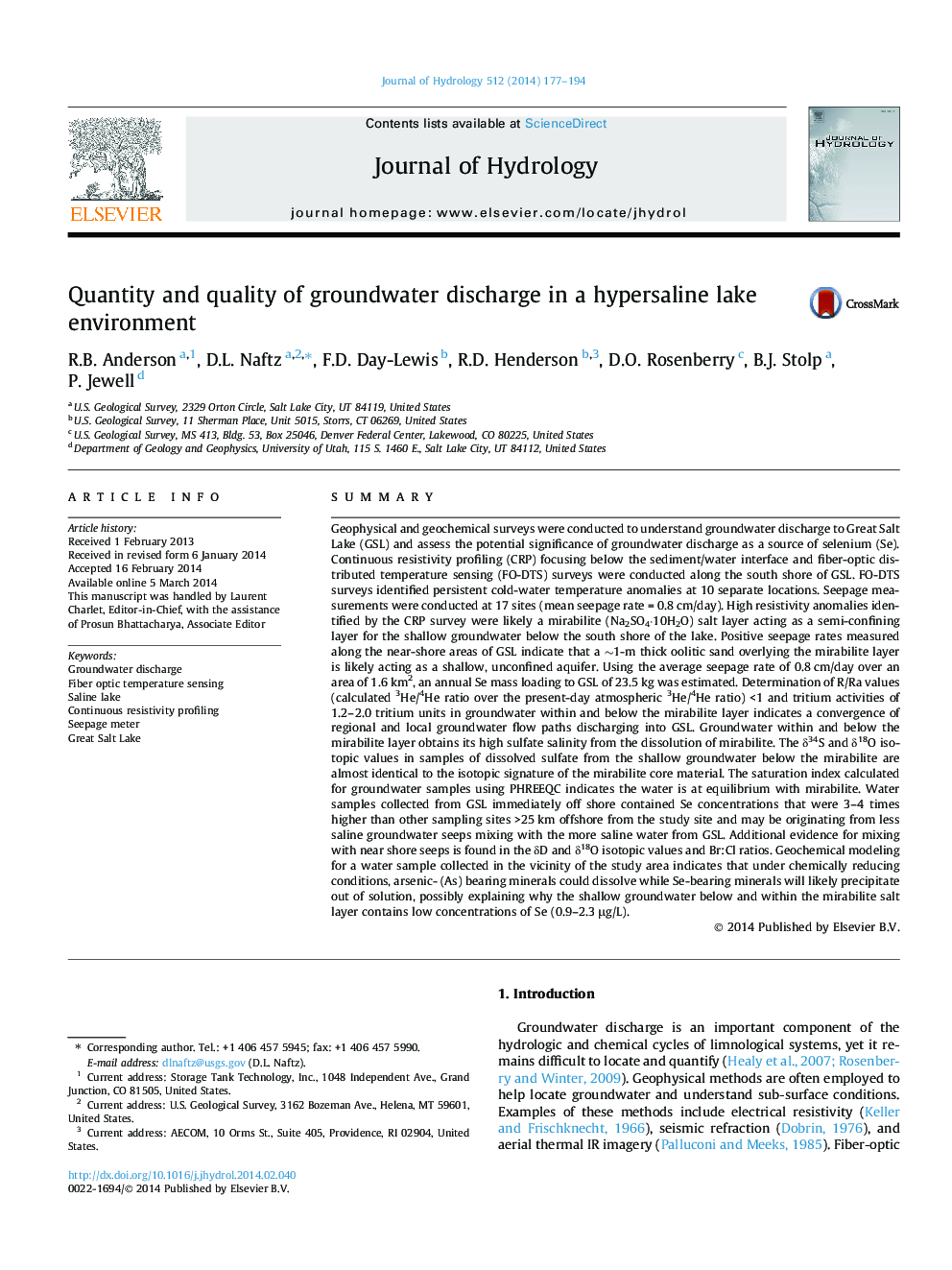| کد مقاله | کد نشریه | سال انتشار | مقاله انگلیسی | نسخه تمام متن |
|---|---|---|---|---|
| 6413130 | 1629936 | 2014 | 18 صفحه PDF | دانلود رایگان |

- We detected temperature anomalies at 10 locations along the south shore.
- We found the high resistivity sub-surface anomalies were mirabilite salt layers.
- Measured seepage rates to Great Salt Lake averaged 0.8Â cm/day.
- Near shore water samples contain elevated selenium concentrations.
- Tritium concentrations in groundwater indicate mixing of old and young water.
SummaryGeophysical and geochemical surveys were conducted to understand groundwater discharge to Great Salt Lake (GSL) and assess the potential significance of groundwater discharge as a source of selenium (Se). Continuous resistivity profiling (CRP) focusing below the sediment/water interface and fiber-optic distributed temperature sensing (FO-DTS) surveys were conducted along the south shore of GSL. FO-DTS surveys identified persistent cold-water temperature anomalies at 10 separate locations. Seepage measurements were conducted at 17 sites (mean seepage rate = 0.8 cm/day). High resistivity anomalies identified by the CRP survey were likely a mirabilite (Na2SO4·10H2O) salt layer acting as a semi-confining layer for the shallow groundwater below the south shore of the lake. Positive seepage rates measured along the near-shore areas of GSL indicate that a â¼1-m thick oolitic sand overlying the mirabilite layer is likely acting as a shallow, unconfined aquifer. Using the average seepage rate of 0.8 cm/day over an area of 1.6 km2, an annual Se mass loading to GSL of 23.5 kg was estimated. Determination of R/Ra values (calculated 3He/4He ratio over the present-day atmospheric 3He/4He ratio) <1 and tritium activities of 1.2-2.0 tritium units in groundwater within and below the mirabilite layer indicates a convergence of regional and local groundwater flow paths discharging into GSL. Groundwater within and below the mirabilite layer obtains its high sulfate salinity from the dissolution of mirabilite. The δ34S and δ18O isotopic values in samples of dissolved sulfate from the shallow groundwater below the mirabilite are almost identical to the isotopic signature of the mirabilite core material. The saturation index calculated for groundwater samples using PHREEQC indicates the water is at equilibrium with mirabilite. Water samples collected from GSL immediately off shore contained Se concentrations that were 3-4 times higher than other sampling sites >25 km offshore from the study site and may be originating from less saline groundwater seeps mixing with the more saline water from GSL. Additional evidence for mixing with near shore seeps is found in the δD and δ18O isotopic values and Br:Cl ratios. Geochemical modeling for a water sample collected in the vicinity of the study area indicates that under chemically reducing conditions, arsenic- (As) bearing minerals could dissolve while Se-bearing minerals will likely precipitate out of solution, possibly explaining why the shallow groundwater below and within the mirabilite salt layer contains low concentrations of Se (0.9-2.3 μg/L).
Journal: Journal of Hydrology - Volume 512, 6 May 2014, Pages 177-194